Orthodontics/Braces
F.A.Q on Types of Braces
Different types of braces are used to correct the alignment of teeth. Orthodontic treatment is usually synonymous with braces. The results of braces treatment can be dramatic — beautiful smiles, improved dental health and an enhanced quality of life for people of all ages. With so many types of braces to choose from, one can often get confused while selecting the right type of braces best suited for them.
Dr.Smilez provides complete information on how to choose the latest and most effective type of braces in Chennai for all age groups.
What are the different types of braces?
- The most common type of braces is the conventional metal braces.
- For more esthetic conscious patients, that are tooth-colored are available.
- The newer self-ligating braces are a special type of braces that is different from the conventional type of braces. They are smaller in size and do not need the conventional rubber bands to hold the wire to the bracket. Most orthodontists prefer the new self-ligating type of braces as the results are very good with maximum comfort to the patient.
- A less popular type of braces is Lingual braces where the brackets are stuck on the insides of the teeth to avoid visibility. This type of braces is not suited for many situations and is less comfortable for the patient compared to the other types of braces. Lingual braces are often misunderstood to be invisible braces.
- Invisible braces, however, are the newest method of tooth alignment that is done with Clear Aligners (Invisalign). Invisalign is a patented technology which uses a set of transparent invisible trays to progressively align teeth.
Which type of braces is the best?
All types of braces are equally good and provide the best results in the hands of a good orthodontist. There are multiple options available and a good brand is recommended compared to cheaper imitation braces for best results. At Dr.Smilez, we use only standard brands such as 3M, Damon Braces, American Orthodontics, etc and our orthodontists will recommend the most suitable type of braces for each patient based on the clinical condition and the complexity of tooth movement.
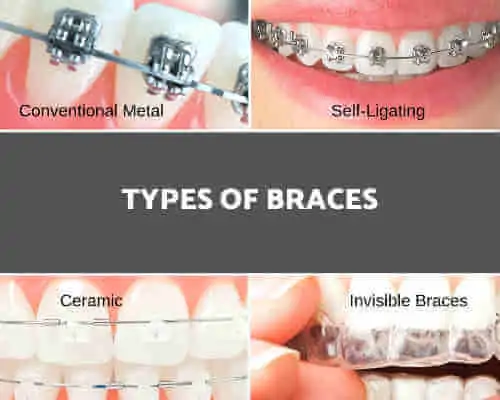
Which type of braces is more effective?
In general, most alignment problems can be corrected best with braces stuck on the outside of the teeth. The newer self-ligating type of braces is more effective than the conventional type of braces in this regard in that the treatment time is reduced. Lingual braces and Invisible braces (Clear Aligners) are not recommended for all clinical situations are most effective only for simple corrections.
How do I choose the type of braces for my teeth?
The choice of braces depends on many factors, including the complexity of the treatment required, the time frame for the entire treatment, the clinical condition of the gums and also the cost. While you can choose the type of braces best suited to your pocket, sometimes it may be necessary to opt for a different system based on the opinion of your orthodontist.
Ceramic Vs Metal: Which type of braces is better?
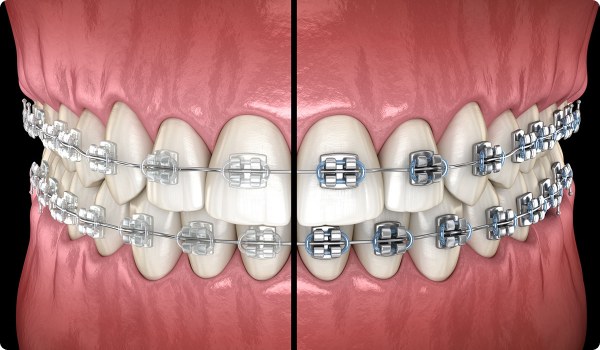
Ceramic type of braces is usually preferred by teens and adults who do not want visible metal showing in their smile during treatment. Ceramic braces are tooth-colored and blend in better with the natural tooth shade and are less obvious compared to metal braces. Financial preference is also considered when choosing between ceramic and metal type of braces. One can also mix and match the different type of braces such that ceramic braces is used for the visible upper teeth and metal braces is used for the other teeth.
What is the right age for Braces Treatment?
The right age is as young as 6 years! Orthodontics also includes functional and preventive orthodontics, to correct developing skeletal or dental malocclusion, and is usually overlooked. At this age, persistent habits such as thumb sucking, mouth breathing, and tongue thrusting have to be intercepted. When treated correctly, the dental problems arising from such habits such as open bite can be easily contained. Subsequent monitoring at 7 years, 9 years and 11 years are required for every child to coincide with the eruption of permanent teeth. Developing problems can be easily prevented. This includes problems in the growth of jaws too; either too small or too big. During the growing phase till puberty, these developing growth discrepancies can be easily identified and corrected with simple appliances. Any skeletal problem after puberty can only be corrected by surgery.
Is there any upper age limit for braces treatment?
NO! Braces can be done at any age provided the gums and bone are in good health. As age advances the duration of treatment may be longer than the younger age group due to the increase in density of bone. The type of braces for adults is best chosen by the orthodontist for optimum results.
What is the success of Braces treatment?
The alignment of teeth will be successful irrespective of the types of braces. The most important phase that contributes to long term success of braces treatment is the retention phase. After alignment is complete, retainers must be worn for at least one year in order to prevent relapse. At Dr.Smilez, we always ensure optimum success and is one of the most preferred clinics for braces in Chennai.
What is the duration of braces treatment?
The duration usually depends on the complexity of tooth movement and the type of braces chosen. On average, the treatment time can range from 8 months – 24 months.
What are retainers?
Retainers are used after active braces treatment is completed. Your braces will be removed and retainers will be made which can be fixed or removable. This has to be worn for a minimum of one year.
Why should I wear retainers?
During active orthodontic treatment with braces, teeth are moved within the bone and can sometimes feel loose during this time. When the alignment is complete, teeth are moved into a new position and has to be stabilized by new bone formation. This is the period of retention. Failure to wear retainers will cause the teeth to move back to their original position.
We hope that the above information was useful to help you decide on the types of braces that are available. As you can see from the information, there are specific clinical parameters to decide on the types of braces as well as the usability of aligners. This is best left with the orthodontist to decide. Dr.Smilez is preferred as the best dental clinic for braces in Chennai due to our evidenced-based approach and best practices in the treatment
Conventional Metal Braces
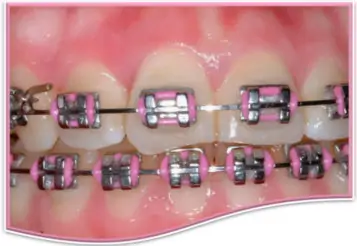
Advantages
- Most commonly used system
- Can be done by most orthodontists
- Fewer chances of the breakage
- Mostly preferred by children
- Most affordable system
Disadvantages
- Oldest (possibly outdated?) system
- Bracket size is very large
- Irritation to lips and cheeks
- Unsightly due to large bracket size
- Food restrictions are high
- Longer treatment duration compared to self-ligating braces
Conventional Ceramic Braces

Advantages
- Tooth-colored, hence more esthetic than metal braces
- More comfortable than metal braces
- Easier to maintain
Disadvantages
- Chances of breakage are higher than conventional metal braces
- Can take up stains and change color
- Longer duration of treatment compared to self-ligating braces
Damon Braces (Self-Ligating Braces)
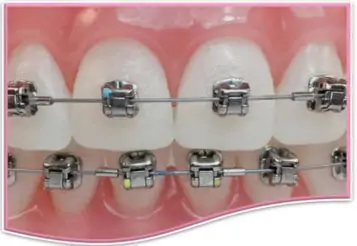

Advantages
- Newer braces system that has a self-locking clip mechanism; hence no need for rubber bands
- Brackets are smaller in size so more esthetic
- Easier to maintain
- Faster treatment (by 25%) compared to conventional braces
- Is available as metal (Damon Braces) or clear (Damon clear)
- Accepted worldwide
- Suitable for all age groups
Disadvantages
- More expensive than conventional braces
- Can be done only by qualified specialists
Invisible Braces/Clear Aligners
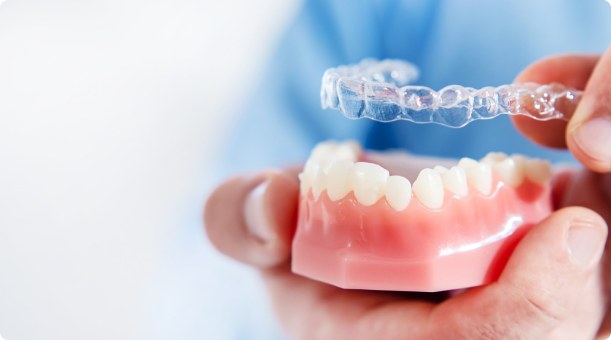
What are aligners?
Aligners are clear, transparent sequential set of trays that fit snugly onto your teeth and effect tooth movement in stages. Aligners are made using CAD/CAM technology to custom design your smile. So here there is no need for any attachment to the teeth, no need for wires or rubber bands! And they are Invisible!
Do Aligners really work?
They do! Aligners also provide the same results in alignment as braces. However, the alignment takes more time than conventional braces, especially for complex tooth movements.
Does it hurt during the process of Aligners?
Any tooth alignment involves the application of forces to move the teeth. Depending on the type of tooth movement required, the forces differ. When tooth movement happens, there is a pressure sensation on the teeth that can sometimes be perceived as pain. With invisible braces being removable, some pressure/pain is felt in the first three to four days when a new aligner is worn especially while removing and reinserting for brushing and eating.
Do I have to wear the Aligners continuously?
YES! It is recommended that each aligner be work for a minimum of 22 hours per day, without which the treatment will not be successful. The aligner is changed every 15 days or as recommended by the dentist.
Are aligners expensive?
In comparison with Braces, Invisible braces or Clear Aligners are more expensive. The high cost is due to the improved technology and predictability of the results. The cost of treatment depends on the number of aligners required which is dictated by the extent of tooth movement required.
Which is the best aligner available?
There are many providers in the current market, but treatment with aligners is best done with known brands such as Invisalign, Clear Correct, K-Line, etc. These are international brands and are more expensive than the locally available lab fabricated invisible braces. Although expensive, the results and follow up care is more predictable than the local aligners.
Additional Important Information on Invisible Braces/Clear Aligners
The thought of getting a perfect smile without the need for braces and with minimal visits to the dentist is very exciting. However, there are other challenges that may not make you the ideal candidate for invisible braces.
- The brand of the Aligner matters – Most people prefer to opt for the less expensive local aligners. However, the more tested and long-lasting brands are a better choice to provide optimum results
- Attachments – For certain types of tooth movements, small attachments such as buttons will be required for effecting the movement. This attachment can be placed only by a qualified dentist and has to be maintained throughout the treatment after which they can be removed. Damaging the attachments can result in the delay of tooth movement
- IPR – Interproximal reduction is sometimes required for certain teeth to create required spaces for correcting especially crooked teeth. Depending on the amount of IPR required and the enamel thickness, sometimes, tooth sensitivity can occur
- Refinement Aligners – Sometimes due to size or structural position, some teeth may be resistant to movement with invisible braces. After completion of the treatment aligner, some refinement aligners may be required for final finishing and perfecting the alignment. A new scan or measurement of your teeth will be required to provide the refinement aligners.
- Retainers – Even with Invisible braces, retainers have to be worn for the recommended duration to prevent relapse of the original .problem
- Patient Motivation – Invisible braces work only if the aligners are worn for the recommended duration of time every day. Some patients get demotivated after the initial few aligners due to the restrictions during usage.
Advantages
- Latest technology
- No brackets/wires/rubber bands/attachments on teeth
- CAD-CAM designed the custom-made smile
- Ability to view the treatment outcome even before starting treatment
- Virtually invisible/Highly comfortable
- Removable; hence no food restrictions
- Easy maintenance
- Minimal appointments/fewer visits
- No dental emergencies due to broken wire/bracket
- Ideal for frequent travellers/overseas patients
Disadvantages
- The cost of treatment can be high
- The cost of treatment can be high
- It may not be preferred in complex tooth movement
- Not indicated for children
Patient Instructions
- Aligners should be worn throughout the day, for minimum 22 hours. Do not wear aligners while eating and brushing. Always rinse your mouth after eating and rinse the aligner before wearing it back. DO not use a mouthwash unless prescribed by your doctor.
- DO NOT let other people try on your aligner for any reason. Your aligners are custom made and a personal product meant only for your use.
- You will feel tightness or pressure especially for the first 2-3 days of a new aligner. This is normal and expected.
- Change your aligner after the recommended duration of wear and not sooner. Sometimes, you may be required to wear the aligner more than the prescribed duration. Call us if your new aligner does not fit well over your teeth immediately and follow the doctor’s recommendations.
- DON’t discard your previous aligners till your treatment is complete. Wash and clean your aligners and store them safely after the recommended duration of wear.
- Contact us immediately if you have misplaced or broken your aligner.
- You will feel some changes in your bite especially without your aligner during the course of your treatment. This is normal and will be transient. Be patient and complete the treatment course. If the bite is unsettling even after completion of all your treatment aligners, some refinement aligners will be provided for final settling.
- DON’t panic if you see some gaps especially in your front teeth during the course of your treatment. This is normal and will align completely once all the treatment aligners are completed. If you see any residual gaps after the last treatment aligner, contact your doctor immediately. You will need some refinement aligners for final alignment settling.
- Continue to wear your last treatment aligner until your doctor advises you to move onto retainers. If retainers have been supplied in your kit, move onto the retainers after confirmation with your doctor. Failure to follow this will cause immediate relapse. If you require refinement aligners, continue to wear your last available treatment aligner till you receive the refinement aligners.
- If you are traveling or overseas and you are unable to see your doctor for a new scan or measurement for your refinement aligners, continue to wear your last treatment aligner till you return or are able to provide a teeth scan or measurement. This facility is available in most countries worldwide. Self impression kits (https://smiledirectclub.com/) are also available online with instructions in case you are unable to find a scan center close to you.
- Your treatment will be successful only with full compliance and cooperation from your side. Make a habit to email SELF TAKEN ALIGNER FITTING pictures to your doctor every month. This will help us to monitor the progress of your treatment and advise any intervention immediately to help getting you the desired treatment outcome.
- For more information on Invisible braces/clear aligners, please contact Dr.Smilez
